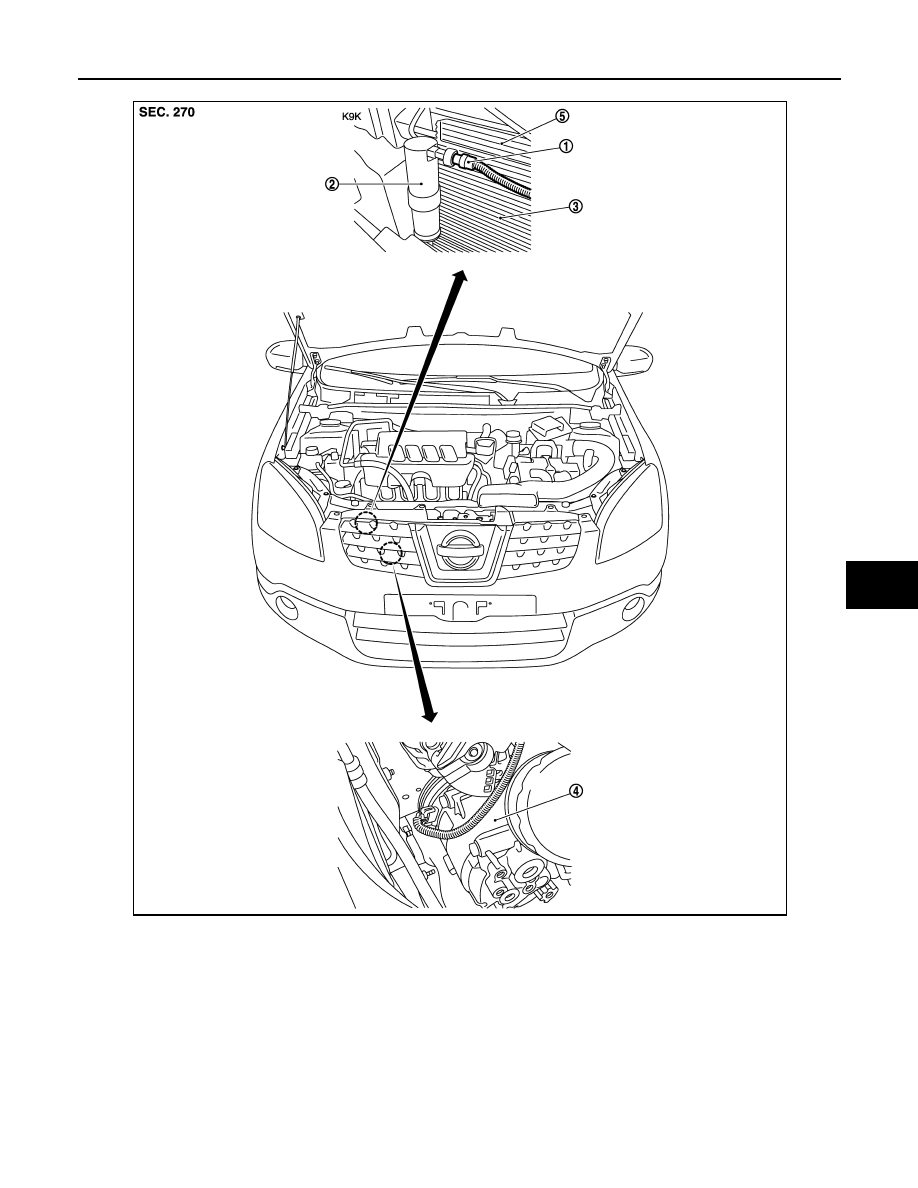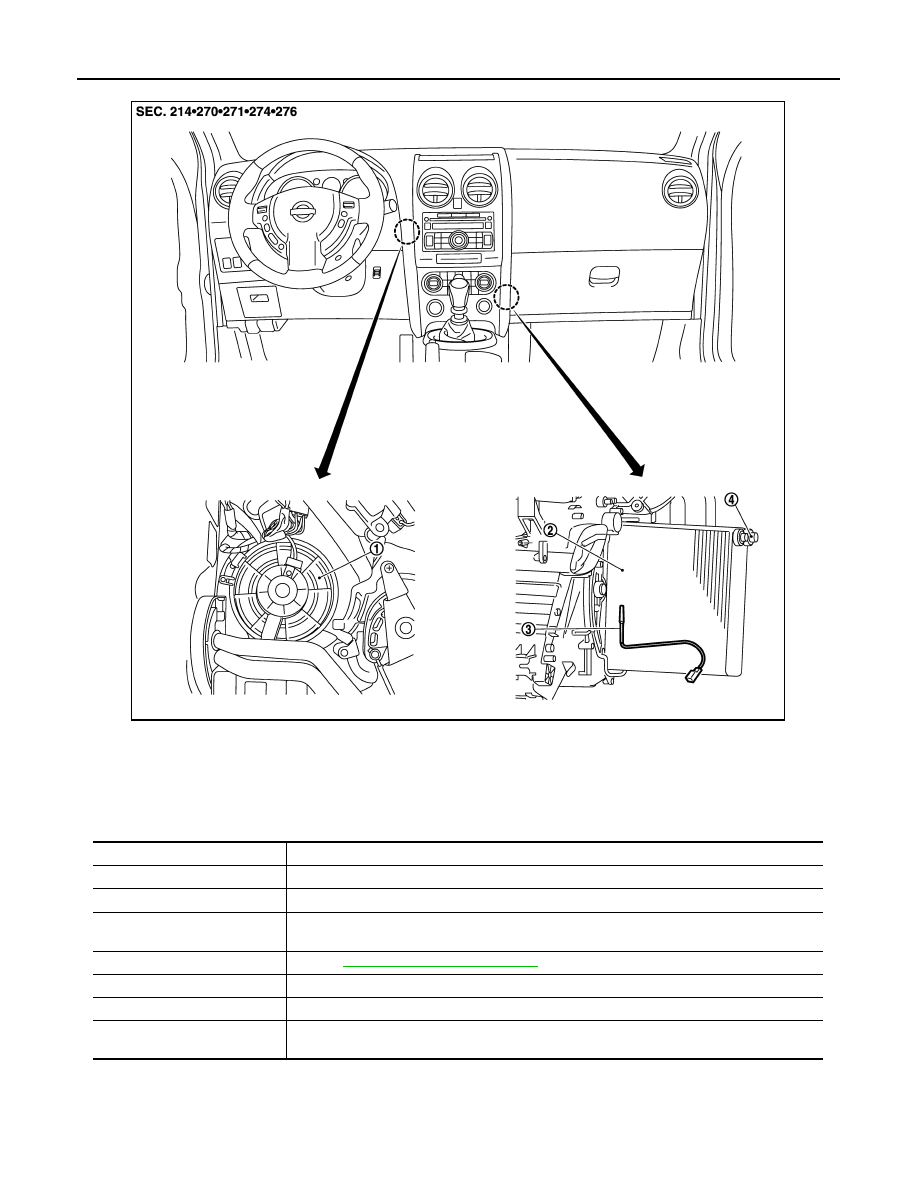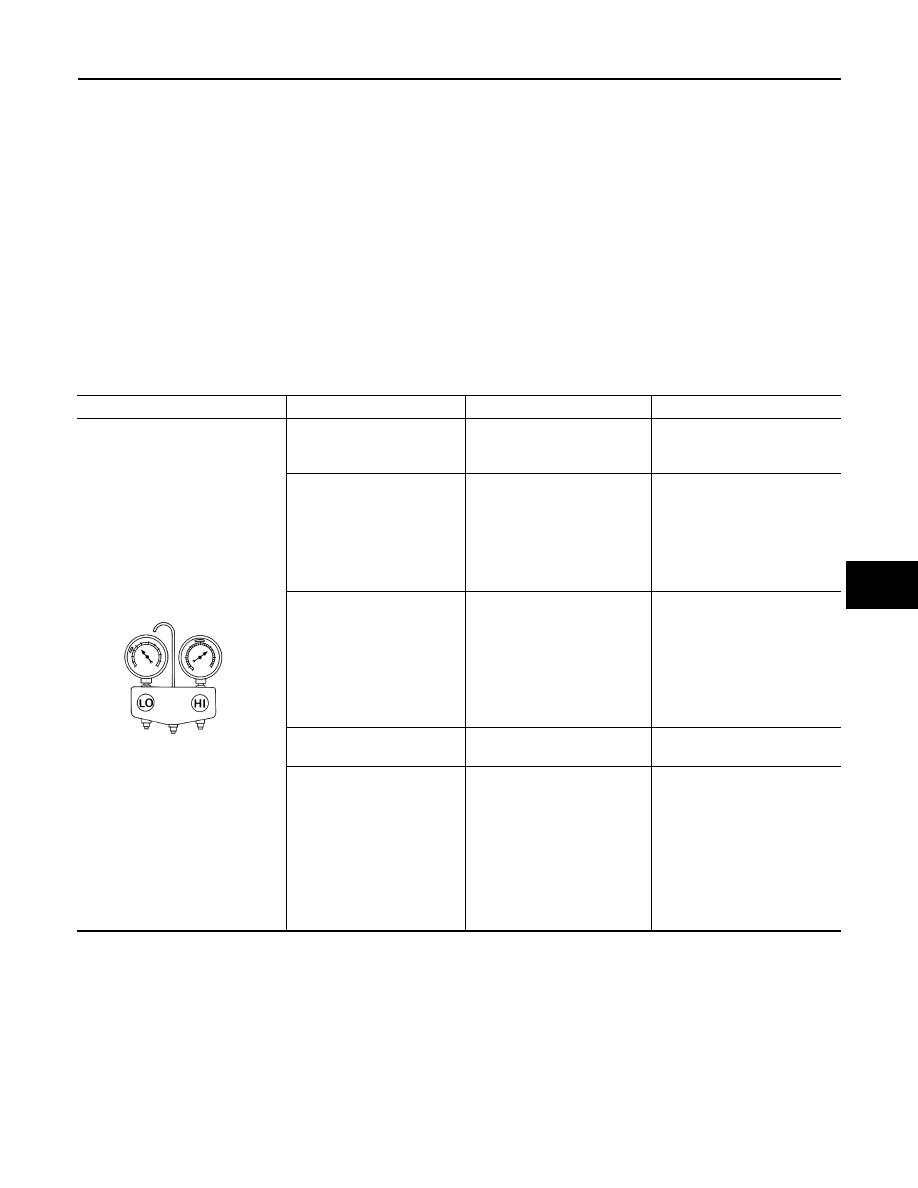Nissan Qashqai (2007-2010). Manual — part 898
HA-162
< FUNCTION DIAGNOSIS >
[MANUAL AIR CONDITIONER (K9K)]
REFRIGERATION SYSTEM
Maintenance of Lubricant Quantity in Compressor
The lubricant in the compressor circulates through the system with the refrigerant. Add lubricant to compres-
sor when replacing any component or after a large refrigerant leakage occurred. It is important to maintain the
specified amount.
If lubricant quantity is not maintained properly, the following malfunctions may result:
• Lack of lubricant: May lead to a seized compressor.
• Excessive lubricant: Inadequate cooling (thermal exchange interference)
Lubricant
Component Parts Location
INFOID:0000000001098257
Name
: Nissan A/C System Oil Type S

REFRIGERATION SYSTEM
HA-163
< FUNCTION DIAGNOSIS >
[MANUAL AIR CONDITIONER (K9K)]
C
D
E
F
G
H
J
K
L
M
A
B
HA
N
O
P
1.
Refrigerant pressure sensor
2.
Liquid tank
3.
Condenser
4.
Compressor
5.
Radiator
E1KIA0033ZZ

HA-164
< FUNCTION DIAGNOSIS >
[MANUAL AIR CONDITIONER (K9K)]
REFRIGERATION SYSTEM
Component Description
INFOID:0000000001098258
1.
Blower motor assembly
2.
Evaporator
3.
Intake sensor (AT only)
4.
Expansion valve
E1KIA0034ZZ
Component
Description
Compressor
Intakes, compresses, and discharges refrigerant, then conveys it to condenser.
Condenser
Condenses refrigerant, and then conveys it to liquid tank.
Liquid tank
Drives moisture out of refrigerant, eliminates foreign matter, then conveys refrigerant to expan-
sion valve.
Refrigerant pressure sensor
Refer to
HAC-161, "Component Inspection"
.
Expansion valve
Vaporizes refrigerant, controls the amount of flow, then conveys refrigerant to evaporator.
Evaporator
Cools passing air, and then conveys it to compressor.
Blower motor
Takes in air in the vehicle or fresh outside air, and then adjusts room temperature by air condi-
tioning.

REFRIGERATION SYSTEM SYMPTOMS
HA-165
< SYMPTOM DIAGNOSIS >
[MANUAL AIR CONDITIONER (K9K)]
C
D
E
F
G
H
J
K
L
M
A
B
HA
N
O
P
SYMPTOM DIAGNOSIS
REFRIGERATION SYSTEM SYMPTOMS
SYMPTOM DIAGNOSIS PROCEDURE
SYMPTOM DIAGNOSIS PROCEDURE : Trouble Diagnosis For Unusual Pressure
INFOID:0000000001098261
Whenever system’s high and/or low side pressure(s) is/are unusual, diagnose using a manifold gauge. The
marker above the gauge scale in the following tables indicates the standard (usual) pressure range. Since the
standard (usual) pressure, however, differs from vehicle to vehicle, refer to above table (Ambient air tempera-
ture-to-operating pressure table).
BOTH HIGH- AND LOW-PRESSURE SIDES ARE TOO HIGH
BOTH HIGH- AND LOW-PRESSURE SIDES ARE TOO HIGH : Symptom Table
INFOID:0000000001098262
HIGH-PRESSURE SIDE IS TOO HIGH AND LOW-PRESSURE SIDE IS TOO LOW
HIGH-PRESSURE SIDE IS TOO HIGH AND LOW-PRESSURE SIDE IS TOO LOW :
Symptom Table
INFOID:0000000001098263
Gauge indication
Refrigerant cycle
Probable cause
Corrective action
Both high- and low-pressure sides
are too high.
The pressure returns to nor-
mal is reduced soon after wa-
ter is splashed on condenser.
Excessive refrigerant charge in
refrigeration cycle.
Reduce refrigerant until speci-
fied pressure is obtained.
Air suction by cooling fan is in-
sufficient.
Insufficient condenser cooling
performance.
↓
1.
Condenser fins are
clogged.
2.
Improper fan rotation of
cooling fan.
• Clean condenser.
• Check and repair cooling fan
as necessary.
• Low-pressure pipe is not
cold.
• When compressor is
stopped high-pressure val-
ue quickly drops by approx-
imately 196 kPa (2 kg/cm
2
,
28 psi). It then decreases
gradually thereafter.
Poor heat exchange in con-
denser
(After compressor operation
stops, high-pressure decreas-
es too slowly.).
↓
Air in refrigeration cycle.
Evacuate repeatedly and re-
charge system.
Engine tends to overheat.
Engine cooling systems mal-
function.
Check and repair each engine
cooling system.
• An area of the low-pressure
pipe is colder than areas
near the evaporator outlet.
• Low-pressure pipe is some-
times covered with frost.
• Excessive liquid refrigerant
on low-pressure side.
• Excessive refrigerant dis-
charge flow.
• Expansion valve is open a lit-
tle compared with the speci-
fication.
↓
Improper expansion valve ad-
justment.
Replace expansion valve.
AC359A

Нет комментариевНе стесняйтесь поделиться с нами вашим ценным мнением.
Текст